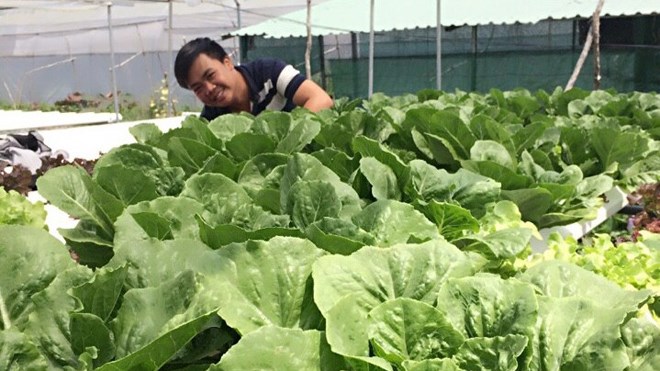Two students in Can Tho City are using waste from seafood processing factories to create microbiological sludge to grow safe vegetables and ornamental flowers.
 Nguyen Huu Huy Hao, a third year student of the Can Tho Economics & Polytechnic College, and Phan Hong Muc, a third year student of the Can Tho University of Technology, defeated another 200 projects in the Mekong Delta to win the first prize at the ‘Y tuong khoi nghiep’ (Ideas for startups) competition initiated by the SIMVA Project.Hao and Muc were the representatives for the Mekong Delta at the national competition on innovative entrepreneurial ideas launched by the Vietnam Student Association’s central committee. The final round of the competition will be held in Hanoi in March 2017.
Nguyen Huu Huy Hao, a third year student of the Can Tho Economics & Polytechnic College, and Phan Hong Muc, a third year student of the Can Tho University of Technology, defeated another 200 projects in the Mekong Delta to win the first prize at the ‘Y tuong khoi nghiep’ (Ideas for startups) competition initiated by the SIMVA Project.Hao and Muc were the representatives for the Mekong Delta at the national competition on innovative entrepreneurial ideas launched by the Vietnam Student Association’s central committee. The final round of the competition will be held in Hanoi in March 2017.
| Vietnam is losing big resources as it cannot take full advantage of the waste produced by seafood processing factories. If their idea of re-using the waste is realistic, this will not only help create a new good source of fertilizer for plants, but also help mitigate the impact on the environment. |
Hao said he had seen increasingly serious pollution caused by waste from seafood processing factories in Ca Mau and Bac Lieu. In early 2016, when implementing experiments on treating waste water with the teachers at the college, he found that the waste sludge after water treatment was left unused. The waste sludge contains many organic matters and does not contain chemicals or heavy metals. According to Hao, activated sludge after sedimentation contains many good organic substances which can be used together with other substances to grow orchids and vegetables. Muc said that Vietnam is losing big resources as it cannot take full advantage of the waste produced by seafood processing factories. If their idea of re-using the waste is realistic, this will not only help create a new good source of fertilizer for plants, but also help mitigate the impact on the environment. Hao’s and Muc’s microbiological sludge products have been used at many farms in Can Tho City and Mekong Delta’s provinces. Nguyen Van Phong, the owner of a vegetable farm in Can Tho City, is trying the sludge for the new vegetable and tomato varieties imported from the Netherlands. “The plants have been growing very well thanks to high nutrition level,” he said, adding that he plans to use the microbiological sludge for the whole farm. Nguyen Tri Thanh in Cai Rang district, who has been using the sludge for one month, confirmed that the proportion of nitrogen in the soil fertilized with the sludge is three to four times higher than normal, thus helping plants grow well and saving money for fertilizer.
















